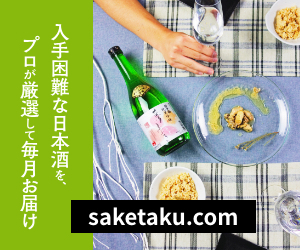- Home
- Drinking at home
- Uokyu’s Kyokasu-zuke! Which fish matches “Hohai” the best?
Uokyu’s Kyokasu-zuke! Which fish matches “Hohai” the best?
- 2019/6/30
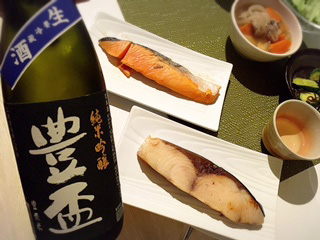
Good day!
This is the second report by a writer “R”!
I’m a housewife in the middle of child raising who used to be a yoga instructor.
I love good foods, and I sometimes enjoy sake as the reward for the busy for myself.
Today I’d like to report a dinner at my home in which I tried Uokyu’s Kyokasu-zuke and a sake, “Hohai”.
Contents
“Hohai Junmai Ginjo Yamadanishiki 55 Namazake”
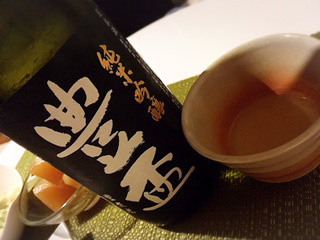
Hohai’s brewery is in Hirosaki City, Aomori.
From some kinds of “Hohai” brand, I chose “Junmai Ginjo Yamadanishiki 55 Namazake” for that time.
“Yamadanishiki” is a name of popular rice which is grown in Hyogo Prefecture in the less agrichemical method.
As the name says, the rice is polished to the 55% of the original volume.
This one is the limited label which was made without heating, and laid for a half year.
Hohai has many fans., and
Iit’s especially popular for the gift for Father’s Day.
Those fans are longing for the sales season to start every year.
“Hohai Namazake” which I tried was very fruity, and it was fresh like a green apple. The aftertaste was light and I thought that it was nice on a hot day.
(“Namazake” is a type of sake which is not heated at all in the recipe. I want to compare it with Hohai which is non-Namazake = “heated” if I have a chance!!)
Who chose “Hohai” was my husband.
I asked him to choose a good sake for Kasu-zuke for dinner, and he brought “Hohai”.
(He has a license of “Sake Sommelier”.)
Uokyu’s Kasu-zuke
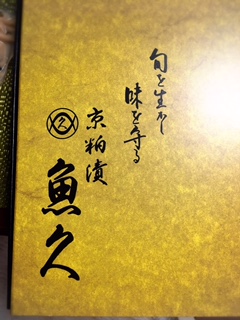
“Uokyu” is the name of a maker which makes Kasu-zuke, and their official name is “Kyokasu-zuke Uokyu”.
They are my favorite Kasu-zuke maker.
I’d like to introduce Uokyu briefly.
“Kasu-zuke” is fish and vegetables which were pickled in the sake ingredients after squeezing the liquid.
It’s been familiar with Japanese people as preservative foods since the Heian period.
In making sake, rice becomes “Moromi” after fermenting which is the mother of SakeNihonshu. NihonshuSake is squeezed out from Moromi after further fermenting.
The remaining solid after taking out the liquor is called “Sake Kasu”.
“Sake Kasu” contains much elements to make the flavor of Nihonshu, so it’s delicious by itself.
It has rich nutritious as well, so it’s good for health and beauty.
The establishment of Uokyu is in the Taisho period, and their history is very long.
The following is the summary of the introduction in Uokyu’s website.
Uokyu’s original shop is a high-class fish dealer “Uokyu Shoten” which was established in Kakigara-cho, Tokyo, in 1914.
They started to do catering later, not only selling fish.
In 1940, they opened a restaurant, “Edo-fu Kappou Uokyu“.
They served Kasu-zuke in this restaurant, and it became very popular.
Many people requested their Kasu-zuke to take out for souvenirs, so Uokyu opened the present Kasu-zuke-supecialized shop in 1965.
The good reputation is still alive now.
I tried Kasu-zuke of some different types of fish with Hohai.
I felt that the combination of Kasu-zuke and Nihonshu Sake can’t be bad once again.
I have only tried few makers of Kasu-zuke, but I feel that Uokyu’s quality is special.
Hohai which is perfect with Uokyu
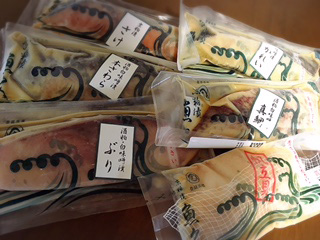
The Kasu-zuke which was presented to us from someone was an assortment of different fish.
We chose Gindara (black cod) and Kajiki (spearfish) for dinner.

Gindara had rich fat and it was just delicious!
The Sake Kasu flavor and the chilled Hohai matched very well.
The fruity taste of Hohai wrapped Gindara’s fat, and they made the sake flavors of each other richer.
Kajiki had lighter taste and texture than Gindara. It had moisture nicely.
It had stronger taste of Sake Kasu than Gindara.
The combination with Hohai was good, so I couldn’t stop eating and sipping.
I tried Sake (salmon) and Buri (yellowtail) on another day.

Hohai a few days after opening increased sweetness and became milder.
Sake’s characteristic flavor became mild by being pickled in Sake Kasu.
Of course, the combination with Hohai was very good!
(I personally thought that it was better if it tasted of salmon more.)
Buri had hard texture, but some parts were soft and melted in my mouth.
I enjoyed the texture very much.
As I chewed, the sweetness and sake flavor of Kasu-zuke came out.
The combination of Buri and Hohai made the dry taste of the sake clearer than other fish.
I liked Gindara the best for Hohai in the 4 different Kasu-zuke.
The reason is the good feeling of Hohai washing the fat of Gindara away from my mouth.
It was a bit surprising to hear that my husband said that he liked the combination of a daikon dish and Hohai.
It was pieces of daikon radish which were cooked in fish stock, soy sauce, Mirin (sweet cooking sake), cooking sake, and sugar.
The daikon was still cold after I took it out from the fridge., and m
My husband said that it was the important part to match Hohai.
We tried the high-class Uokyu’s Kasu-zuke, but I’d like to try normal reasonable Sake Kasu as well.
There are assortments of Uokyu’s Kasu-zuke for family use are sold by lower prices at department stores. I will check them, too.
It's our great pleasure if this article is helpful for you.
Restaurant Information
| Shop Name | |
|---|---|
| Prefectures | - |
| Tel | |
| Address | |
| Nearest Station | |
| Homepage | - |
| Business Hours | - |
| Holiday | |
| Introduction | |
| Sake List |
|

